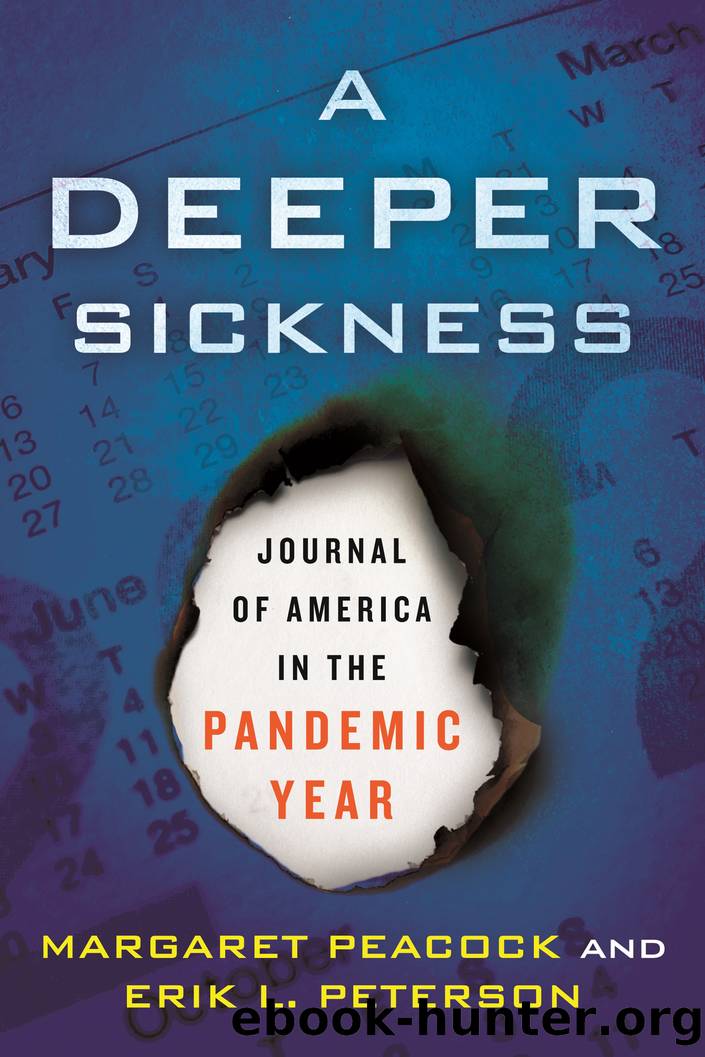A Deeper Sickness by Margaret Peacock

Author:Margaret Peacock [Peterson, Margaret Peacock and Erik L.]
Language: eng
Format: epub
Publisher: Beacon Press
Published: 2022-10-15T00:00:00+00:00
Consumer Purchasing Power, 2016-July 2020. (U.S. Bureau of Labor Statistics and St. Louis Fed)
THURSDAY, AUGUST 20, 2020
Twenty-three weeks since stay-at-home orders were first issuedâ162,000 deaths
Historians Deborah Cohen and Lessie Jo Frazier argue the year 1968 represented, âa long historical moment . . . an idea.â19 The year brought to a head the war in Vietnam; the civil rights movement; the Chicano/a, American Indian, and Asian American liberation struggles; student and feminist movements; decolonial movements in Africa, Latin America, and Asia; and the antinuclear movement. George Wallace ran for the presidency, with plenty of support in rural America. Dr. Martin Luther King Jr. and Robert F. Kennedy were assassinated only weeks apart. The electorate seemed irreparably divided.
On the one hand, that year marked a global outpouring of expression and freedom, what historian Gerd-Rainer Horn called âthe dynamic towards personal and collective liberation.â20 On the other hand, it also rang the death knell for the old political liberalism and the Democratic Party as it had existed.21
At the Democratic National Convention in Chicago that August, Mayor Richard Daleyâs blue-helmeted police dragged from the floor those calling for an antiwar platform. Outside the convention center, National Guard troops tear-gassed protesters and beat them with nightsticks. For people like Daley, âliberalsâ had gone too far. âWhat are we coming to as a society,â he posed, âif policemen are treated the way theyâve been treatedânot only in Chicago, but all over the country?â He blamed the protesters for their own beatings.22 A year later, a National Commission on the Causes and Prevention of Violence, formed one year after the better-known Kerner Commission, resolved that the police used excessive force: âThere was enough wild club swinging, enough cries of hatred, enough gratuitous beating to make the conclusion inescapable that individual policemen, and lots of them, committed violent acts far in excess of the requisite force for crowd dispersal or arrest.â23
Much like the Kerner Commission in 1967, this National Commission in 1968 resulted in a large report and little actual reform. Instead, Richard Nixon, who painted himself as the defender of law and order, harnessed the memory of that night to enlist his âsilent majorityâ of Americans who viewed protest and civil rights as democracy gone too far. The entrenched pro-business Republican Party shifted colors to become the new defender of law and order, property, family values, the Second Amendment, and white resentment toward racial and ethnic minority groups attempting to be included in the American Dream.24
Given the conflict of this year, one might be tempted to use 1968 as a model for anticipating this yearâs Democratic National Convention. They are, however, nothing alike. This yearâs affair happens virtually, with each speaker tuning in from home. Each reads from a script in front of a carefully manicured background. It feels like one long commercial targeting people who are already sold on the product. Vice presidential candidate Kamala Harris becomes the highlight, bringing a sense of closeness and realism, substance and gravitas. Former vice president Joe Biden speaks cogently about the issues of the day, and everyone sighs with relief.
Download
This site does not store any files on its server. We only index and link to content provided by other sites. Please contact the content providers to delete copyright contents if any and email us, we'll remove relevant links or contents immediately.
Periodization Training for Sports by Tudor Bompa(8208)
Why We Sleep: Unlocking the Power of Sleep and Dreams by Matthew Walker(6648)
Paper Towns by Green John(5133)
The Immortal Life of Henrietta Lacks by Rebecca Skloot(4546)
The Sports Rules Book by Human Kinetics(4333)
Dynamic Alignment Through Imagery by Eric Franklin(4166)
ACSM's Complete Guide to Fitness & Health by ACSM(4018)
Kaplan MCAT Organic Chemistry Review: Created for MCAT 2015 (Kaplan Test Prep) by Kaplan(3965)
Introduction to Kinesiology by Shirl J. Hoffman(3741)
Livewired by David Eagleman(3721)
The Death of the Heart by Elizabeth Bowen(3574)
The River of Consciousness by Oliver Sacks(3566)
Alchemy and Alchemists by C. J. S. Thompson(3479)
Bad Pharma by Ben Goldacre(3393)
Descartes' Error by Antonio Damasio(3247)
The Emperor of All Maladies: A Biography of Cancer by Siddhartha Mukherjee(3110)
The Gene: An Intimate History by Siddhartha Mukherjee(3071)
The Fate of Rome: Climate, Disease, and the End of an Empire (The Princeton History of the Ancient World) by Kyle Harper(3029)
Kaplan MCAT Behavioral Sciences Review: Created for MCAT 2015 (Kaplan Test Prep) by Kaplan(2955)
